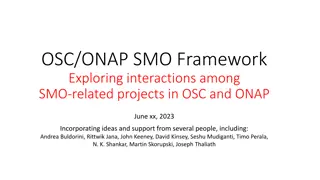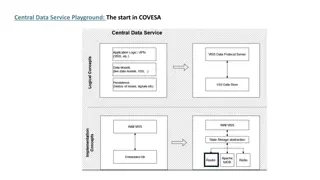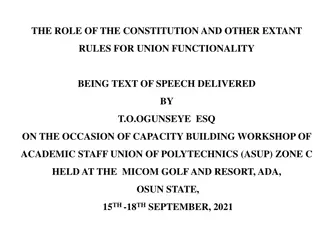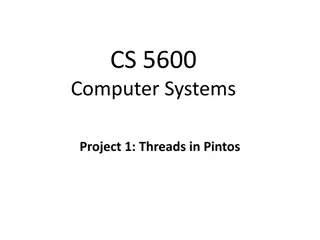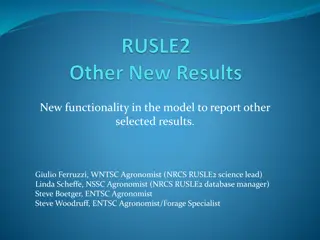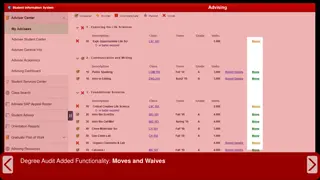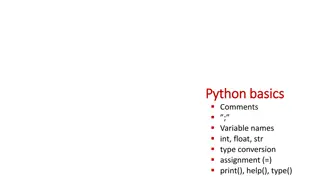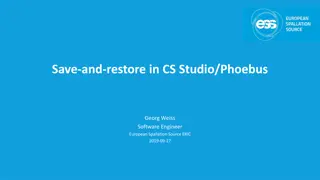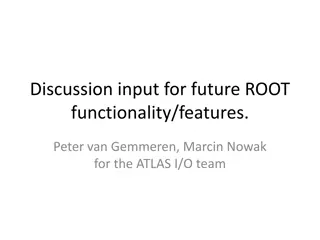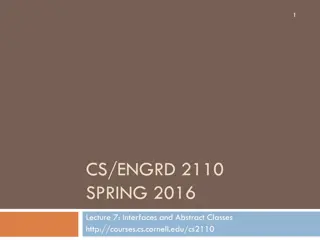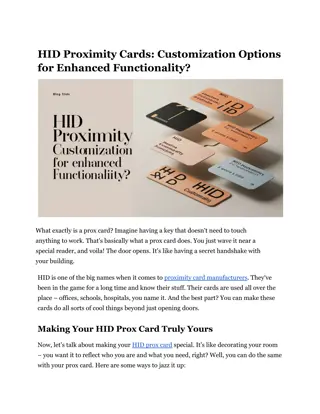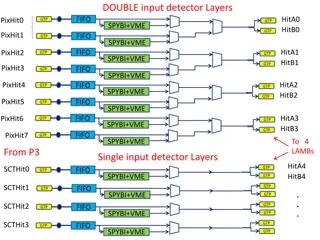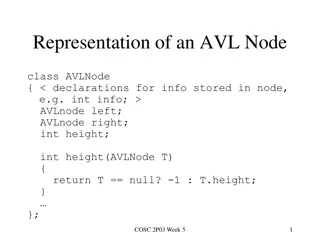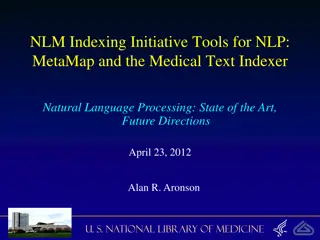Understanding MetaMap: Overview of Concepts and Functionality
MetaMap is a concept mapping program developed by Pawel Matykiewicz and others. It assists in mapping medical terms to concepts in the UMLS database. The program involves input formats, the algorithm, MetaMap options, output formats, and creators. Key features include parsing using SPECIALIST tools, syntactic structure requirements, and variant generation for medical terms. Be cautious with bulleted lists to ensure accurate mapping and tagging of medical terms.
Download Presentation

Please find below an Image/Link to download the presentation.
The content on the website is provided AS IS for your information and personal use only. It may not be sold, licensed, or shared on other websites without obtaining consent from the author. Download presentation by click this link. If you encounter any issues during the download, it is possible that the publisher has removed the file from their server.
E N D
Presentation Transcript
MetaMap UMLS Concept Mapping Program Pawel Matykiewicz and Others
Outline Input Formats (1) The Algorithm (2) MetaMap options (3) Output Formats (4) Creators (5)
Input Formats (1) ASCII only input Unformatted English free text MEDLINE Citations Input records delimited by blank line Single-line delimited input (via job Scheduler) heart attack lung cancer Single-line delimited input with ID (Scheduler) 000001|heart attack 000002|lung cancer
Input Should Have Syntactic Structure Lack of structure long phrases combinatorial explosion in mappings protein-4 FN3 fibronectin type III domain GSH lutathione GST glutathione S-transferase hIL-6 human interleukin-6 HSA human serum albumin IC(50) half-maximal inhibitory concentration Ig immunoglobulin IMAC immobilized metal affinity chromatography K(D) equilibrium constant from filamentous bacteriophage f1 PCR polymerase-chain reaction PDB Protein Data Bank PSTI human pancreatic secretory trypsin inhibitor RBP retinol-binding protein SPR surface plasmon resonance TrxA
The Algorithm (2) Parsing Using SPECIALIST minimal commitment parser, SPECIALIST lexicon, MedPost part of speech tagger Variant generation Using SPECIALIST lexicon, Lexical Variant Generation (LVG) Candidate retrieval From the Metathesaurus Candidate evaluation Mapping construction
Parsing Text Ocular complications of myasthenia gravis. Tagging Ocular complications of myasthenia gravis . adj/2 noun prep noun noun/2 pd Simplified phrases [mod(ocular), head(complications)] [prep(of), head(myasthenia gravis), punc(.)]
Variant Generation Variants of adjective ocular (total 13, 9 occur in UMLS): ocular{[adj], 0=[]} eye{[noun], 2="s"} eyes{[noun], 3="si"} optic{[adj], 4="ss"} ophthalmic{[adj], 4="ss"} ophthalmia{[noun], 7="ssd"} ophthalmias{[noun], 8="ssdi"} ophthalmiac{[noun], 7="ssd"} ophthalmiacs{[noun], 8="ssdi"} oculus{[noun], 3="d"} oculi{[noun], 4="di"} ocularity{[noun], 3="d"} ocularities{[noun], 4="di"}
Candidate Evaluation Phrase: Ocular complications Meta Candidates (8): 861 Complications (Complication) [patf] 861 complications (Complication Aspects) [patf] 777 Complicated [ftcn] 694 Ocular (Eye) [bpoc] 638 Eye (Entire Eye) [bpoc] 611 Optic (Optics) [ocdi] 611 Ophthalmic [spco] 588 Ophthalmia (Endophthalmitis) [dsyn]
Mapping Construction (WSD) Cerebral blood flow (CBF) in newborn infants is Infant, Newborn Cerebrovascular Circulation CEREBRAL BLOOD FLOW IMAGING often below levels necessary to sustain brain viability Frequent Levels (qualifier value) Brain Viable Sustained Entire brain in adults. Adult
MetaMap Options (3) Word Sense Disambiguation (WSD, -y) Based on Susanne Humphrey s Journal Descriptor Indexing (Humphrey et al., 1998, 2006) Provides modest improvement in results Negation (--negex) Important for clinical text Based on Wendy Chapman s NegEx algorithm (Chapman et al., 2001) Behavior options Output/Display options
Behavior Options (1/4) Data model options -A --strict_model(the default; focused on concepts likely to be found in text) -C --relaxed_model(includes most Metathesaurus content) Major options highlighted earlier -y --word_sense_disambiguation --negex Other major options -Q --quick_composite_phrases(experimental, for well-behaved larger phrases: pain on the left side of the chest) -i --ignore_word_order
Behavior Options (2/4) Browse mode options (example below) -z --term_processing -o --allow_overmatches -g --allow_concept_gaps -m --hide_mappings Inference mode options (example below) -Y --prefer_multiple_concepts
Behavior Options (3/4) Parsing/lexical options (not often used) -t --no_tagging -d --no_derivational_variants -D --all_derivational_variants -a --all_acros_abbrs -u --unique_acros_abbrs_only List truncation options (reduces tenuous matches and saves processing time) -r --threshold <integer>
Behavior Options (4/4) Source/ST limitation options -R --restrict_to_sources <list> -e --exclude_sources <list> -J --restrict_to_sts <list> -k --exclude_sts <list>
Behavior Example Superficial injury of chest wall without infection prefer multiple concepts: Superficial , Injury , Chest , Wall , Infection (time elapsed 0.39 sec) quick composite phrases: Superficial , Injury of chest wall , Superficial injury of chest , Wall , Infection (time elapsed 0.88 sec) term processing: Superficial injury of chest wall NOS, infected (time elapsed 0.98 sec) term processing, relaxed model: Superficial injury of chest wall without infection (time elapsed 2.88 sec)
Output Formats (4) Human-readable output MetaMap Machine Output (MMO) XML output Colorized MetaMap output (MetaMap 3D) Fielded (MMI) Output
Output Formats: Human Readable Phrase: "heart attack" Meta Candidates (8): 1000 Heart attack (Myocardial Infarction) [Disease or Syndrome] 861 Heart [Body Part, Organ, or Organ Component] 861 Attack, NOS (Onset of illness) [Finding] 861 Attack (Attack device) [Medical Device] 861 attack (Attack behavior) [Social Behavior] 861 Heart (Entire heart) [Body Part, Organ, or Organ Component] 861 Attack (Observation of attack) [Finding] 827 Attacked (Assault) [Injury or Poisoning] Meta Mapping (1000): 1000 Heart attack (Myocardial Infarction) [Disease or Syndrome]
Output Formats: Machine Output Prolog terms (pretty-printed & condensed!) candidates([ ev(-1000, 'C0027051', 'Heart attack', 'Myocardial Infarction', [heart,attack], [dsyn], [[[1,2],[1,2],0]], yes, no, ['MEDLINEPLUS], [0/12]), ev(-861, 'C0018787', 'Heart', 'Heart', [heart], [bpoc], [[[1,1],[1,1],0]], yes, no, ['AIR'],[0/5]), ev(-861, 'C0277793', 'Attack, NOS', 'Onset of illness', [attack], [fndg], [[[2,2],[1,1],0]], yes, no, ['MTH'], [6/6]), ev(-861, 'C0699795', 'Attack', 'Attack device', [attack], [medd], [[[2,2],[1,1],0]], yes, no, ['MTH','MMSL'], [6/6]), ev(-861, 'C1261512', attack, 'Attack behavior', [attack], [socb], [[[2,2],[1,1],0]], yes, no, ['MTH','PSY','AOD'], [6/6]), ev(-861, 'C1281570', 'Heart', 'Entire heart', [heart], [bpoc], [[[1,1],[1,1],0]], yes, no, ['MTH','SNOMEDCT'], [0/5]), ev(-861, 'C1304680', 'Attack', 'Observation of attack', [attack], [fndg], [[[2,2],[1,1],0]], yes, no, ['MTH','SNOMEDCT'], [6/6]), ev(-827, 'C0004063', 'Attacked', 'Assault', [attacked], [inpo], [[[2,2],[1,1],1]], yes, no, ['ICD10AM'], [6/6])]).
Output Formats: Formatted XML <Candidate> <CandidateScore>-1000</CandidateScore> <CandidateCUI>C0027051</CandidateCUI> <CandidateMatched>Heart attack</CandidateMatched> <CandidatePreferred>Myocardial Infarction</CandidatePreferred> <MatchedWords Count=2><MatchedWord>heart</MatchedWord><MatchedWord>attack</MatchedWord></MatchedWords> <SemTypes Count=1><SemType>dsyn</SemType></SemTypes> <MatchMaps Count=1> <MatchMap> <TextMatchStart>1</TextMatchStart> <TextMatchEnd>2</TextMatchEnd> <ConcMatchStart>1</ConcMatchStart> <ConcMatchEnd>2</ConcMatchEnd> <LexVariation>0</LexVariation> </MatchMap> </MatchMaps> <IsHead>yes</IsHead> <IsOverMatch>no</IsOverMatch> <Sources Count=24><Source>MEDLINEPLUS</Source></Sources> <ConceptPIs Count=1><ConceptPI><StartPos>0</StartPos><Length>12</Length></ConceptPI></ConceptPIs> </Candidate>
MetaMap Fielded MMI Output 17285228|MM|430.78|Homocystine|C0019879|[aapp,bacs]|["Homocystine"-ab-3- "Homocysteine","Homocystine"-ab-2-"homocysteine","Homocystine"-ab-1- "Homocysteine","Homocystine"-ti-1-"homocysteine"]|TI;AB|406:12|227:12|74:12|35:12 17285228 (PMID) MM (Path Name) 430.78 (Score) Homocystine (UMLS Concept Found Preferred Name) C0019879 (UMLS Concept Unique Identifier) [aapp,bacs] (List of Semantic Type(s)) ["Homocystine"-ab-3-"Homocysteine","Homocystine"-ab-2- "homocysteine","Homocystine"-ab-1-"Homocysteine","Homocystine"-ti-1- "homocysteine"] (List of Entry Term Quartets) TI;AB (Location(s), boost scores for TI) 406:12|227:12|74:12|35:12 (List of Positional Information Groups [start:length])
Creators (5) National Library of Medicine (NIH): Alan (Lan) R. Aronson: alan@nlm.nih.gov Dina Demner-Fushman: ddemner@mail.nih.gov Fran ois-Michel Lang: flang@mail.nih.gov James G. Mork: mork@nlm.nih.gov
Conclusions Good for PubMed abstracts Not so good for Clarity progress notes



